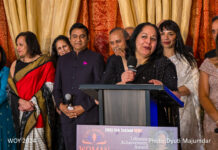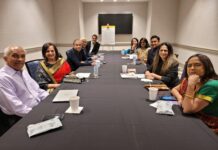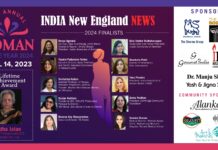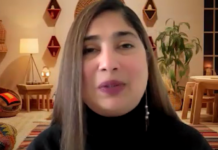 BOSTON – At first, then-University of California professor Mauro Ferrari did not take Tejal Desai seriously when she approached him on the Berkeley campus to see if she could join his researchers. “With how young she looked, I thought it was a practical joke,” Ferrari says. It was 1994 and Desai was new to the university’s Ph.D. program after graduating from Brown University. In some sense, the joke was on Ferrari. “Of all my students, she was the one who was able to reach the greatest level. She was a superstar,” he says, adding that his former students teach at top universities all over the country. At 31, Desai is now a tenured professor at Boston University. A rising star in the field of biomedical engineering, she was B.U.’s top pick as it set out on a multimillion-dollar drive to become one of the top-10 U.S. schools in that field. Since then Desai has been teaching, helping interview job candidates for her department, and continuing with research that has the scientific community excited. Last year, Popular Science magazine included her in its Brilliant 10, a list of young scientists in the United States who are doing extraordinary work. Reshaping the world of medicine While it may sound obscure, biomedical engineering could reshape the world of medicine by, for example, having tiny devices deliver doses of medicine at timed intervals all while in a patient’s body. Along those lines, Desai is an adviser to a California biotech startup that aims to capitalize on research she performed as a grad student. Often the buzz word used for the commercial side of the field is nanotechnology – very small stuff. While in Boston, Desai has continued working with a former colleague at her previous school, the University of Illinois at Chicago. For one, Desai has fabricated cutting-edge materials and shipped them to Chicago. “Tejal is a can-do person,” says Brenda Russell, a biology professor and collaborator at the Chicago school. And baby makes three In the late summer, as Desai was expecting her first baby, the two picked up the pace on finishing a grant application to the National Institutes of Health. “We usually exchange things several times a day by e-mail,” says Russell. Then one day, there were no messages from Desai. “She sort of surfaced a few days later,” says Russell. The baby had been born Sept. 4, making life just that much more complicated. Since then, Desai’s e-mail messages have gotten shorter. “Some of them are at weird times, like 3 a.m., and say ‘the baby just went back to sleep, I’m checking my e-mail,’ ” Russell says. Though she continues to work, Desai spends as much time as possible with baby Tara. She shows up for an interview at a coffee shop with Tara and husband Sanjay Saxena, a consultant for pharmaceutical companies and hospitals. Father and daughter sit at a separate table while Desai chats with a reporter. Desai did not teach in the fall semester, but was doing “everything else.” She is teaching a class this semester. “It’s an adjustment to balance everything,” she adds. Science not her first passion Desai was born in 1972 in Huntington Beach, near Los Angeles, and raised up the California coast in Santa Barbara. She has a brother, Amit, who is six years older. Growing up, she had an array of interests – including traveling abroad and taking part in a model United Nations program while in high school. “Science was something I did well at, but it was not my passion at that point,” she says. But the seeds of her interests were planted early on. For one, her father is a chemical engineer who has worked around the world on water-desalination plants. Her schooling encouraged her interest in science. “I had a seventh-grade teacher who was given to out-of-the-box thinking,” she says. “His class was unlike others. It was hands-on. We went out of the classroom and outdoors.” In high school, she won a spot in a National Science Foundation program geared to girls. She spent eight weeks in New York City – with room and board paid for – learning about the various fields of engineering and science. One guest speaker talked about her own work as a biomedical engineer developing orthopedic implants. This caught Desai’s attention. “It seemed like what she described was a sense of constant change that you had to keep up with,” says Desai. “I liked the idea of never getting bored.” And like being a doctor, one idea Desai had toyed with, such a career carried the opportunity of helping people. ‘She jumped in right away’ Desai went to Brown University, which offered two things she wanted: a liberal arts education and one of the few undergraduate programs in biomedical engineering. By her sophomore year, she had convinced a professor to take her on as a researcher. This got her excited about graduate school. When the University of California’s Ferrari first met Desai, he told her about a very difficult project she could pursue for her Ph.D. “She jumped in right away – she was brave enough to pick up what was offered,” he says. While most students take on projects in which the end result is known in advance, Desai’s project was open-ended – who could say what would come of it. “He basically challenged me,” says Desai. “He said it would be a breakthrough.” As her colleague Russell puts it now: “Tejal is very adventurous, she’s willing to try something – and give it a go.” As a grad student, Desai managed to get pancreas cells to grow inside a microscopic device made of silicon – the stuff of microchips. Inside lab rats, the cells secreted insulin, of which many diabetics need daily injections. The specially designed device allowed the insulin to escape, but kept the animals’ antibodies from doing their job, which would be attacking the pancreas cells as foreign elements. In effect, she had pulled off a microscopic transplant. The work became her Ph.D. thesis. “Nobody in history had ever implanted such a mechanical and biological hybrid into an animal and had it actually treat a disease,” says Ferrari. Into the work force Desai got her Ph.D. in 1998 and was snapped up by the University of Chicago Illinois. She was the first professor for the school’s new biomedical engineering department and helped set up the new curriculum. “It was almost like a startup company – you put together something from scratch,” says Desai. “I was actually very involved in individually recruiting faculty and students.” The next year, she began serving on the scientific advisory board to Intelligent Microengineered Drug Delivery, or IMEDD, a startup founded by Ferrari. IMEDD has looked at such things as using an implant to treat chronic hepatitis C. Desai admits to being attracted to the idea of working for a startup. But, like Ferrari, she does not want to give up academia. “I’d rather be working on science and let other people know about what I’m doing,” she said. Her B.U. lab now does contract work for IMEDD. She’s not just a great scientist In 2001, the Whitaker Foundation – which focuses on biomedical engineering – recognized Boston University as a “national leader.” It granted the school $14 million to renovate and equip new lab space and hire 12 more faculty members in its department. The university kicked in $18 million as well. The chairman of the school’s biomedical engineering department, Ken Lutchen, said he went to talk with a pair of experts. Desai was their top pick in her field, nanotechnology and tissue engineering. Beyond the science, he says, Desai has won teaching awards and has shown her seriousness about building up academic programs. That’s the kind of person the foundation wanted in a department it was funding, he says. “We needed someone who was not just a great scientist sitting in a room with the door closed and publishing some papers,” he says. Desai is not like that at all, says Russell at the Univeristy of Illinois. “She’s very personable,” he says. Ferrari adds: “She has the very best interpersonal and communications skills.” In 2002, Desai answered the lure of working on the East Coast. “Boston is sort of the center of biotech,” its only possible equal being the San Francisco area, she says. Desai has proven an excellent choice, Lutchen says. “She’s been a primary individual helping us recruit new faces,” he says. While Desai has stuck to the academic life – and is not dashing off to work in the private sector – she would love to see people benefiting from her research. “For me, it would be extremely fulfilling to see something you conceive of, just an idea, actually going that far,” she says.
BOSTON – At first, then-University of California professor Mauro Ferrari did not take Tejal Desai seriously when she approached him on the Berkeley campus to see if she could join his researchers. “With how young she looked, I thought it was a practical joke,” Ferrari says. It was 1994 and Desai was new to the university’s Ph.D. program after graduating from Brown University. In some sense, the joke was on Ferrari. “Of all my students, she was the one who was able to reach the greatest level. She was a superstar,” he says, adding that his former students teach at top universities all over the country. At 31, Desai is now a tenured professor at Boston University. A rising star in the field of biomedical engineering, she was B.U.’s top pick as it set out on a multimillion-dollar drive to become one of the top-10 U.S. schools in that field. Since then Desai has been teaching, helping interview job candidates for her department, and continuing with research that has the scientific community excited. Last year, Popular Science magazine included her in its Brilliant 10, a list of young scientists in the United States who are doing extraordinary work. Reshaping the world of medicine While it may sound obscure, biomedical engineering could reshape the world of medicine by, for example, having tiny devices deliver doses of medicine at timed intervals all while in a patient’s body. Along those lines, Desai is an adviser to a California biotech startup that aims to capitalize on research she performed as a grad student. Often the buzz word used for the commercial side of the field is nanotechnology – very small stuff. While in Boston, Desai has continued working with a former colleague at her previous school, the University of Illinois at Chicago. For one, Desai has fabricated cutting-edge materials and shipped them to Chicago. “Tejal is a can-do person,” says Brenda Russell, a biology professor and collaborator at the Chicago school. And baby makes three In the late summer, as Desai was expecting her first baby, the two picked up the pace on finishing a grant application to the National Institutes of Health. “We usually exchange things several times a day by e-mail,” says Russell. Then one day, there were no messages from Desai. “She sort of surfaced a few days later,” says Russell. The baby had been born Sept. 4, making life just that much more complicated. Since then, Desai’s e-mail messages have gotten shorter. “Some of them are at weird times, like 3 a.m., and say ‘the baby just went back to sleep, I’m checking my e-mail,’ ” Russell says. Though she continues to work, Desai spends as much time as possible with baby Tara. She shows up for an interview at a coffee shop with Tara and husband Sanjay Saxena, a consultant for pharmaceutical companies and hospitals. Father and daughter sit at a separate table while Desai chats with a reporter. Desai did not teach in the fall semester, but was doing “everything else.” She is teaching a class this semester. “It’s an adjustment to balance everything,” she adds. Science not her first passion Desai was born in 1972 in Huntington Beach, near Los Angeles, and raised up the California coast in Santa Barbara. She has a brother, Amit, who is six years older. Growing up, she had an array of interests – including traveling abroad and taking part in a model United Nations program while in high school. “Science was something I did well at, but it was not my passion at that point,” she says. But the seeds of her interests were planted early on. For one, her father is a chemical engineer who has worked around the world on water-desalination plants. Her schooling encouraged her interest in science. “I had a seventh-grade teacher who was given to out-of-the-box thinking,” she says. “His class was unlike others. It was hands-on. We went out of the classroom and outdoors.” In high school, she won a spot in a National Science Foundation program geared to girls. She spent eight weeks in New York City – with room and board paid for – learning about the various fields of engineering and science. One guest speaker talked about her own work as a biomedical engineer developing orthopedic implants. This caught Desai’s attention. “It seemed like what she described was a sense of constant change that you had to keep up with,” says Desai. “I liked the idea of never getting bored.” And like being a doctor, one idea Desai had toyed with, such a career carried the opportunity of helping people. ‘She jumped in right away’ Desai went to Brown University, which offered two things she wanted: a liberal arts education and one of the few undergraduate programs in biomedical engineering. By her sophomore year, she had convinced a professor to take her on as a researcher. This got her excited about graduate school. When the University of California’s Ferrari first met Desai, he told her about a very difficult project she could pursue for her Ph.D. “She jumped in right away – she was brave enough to pick up what was offered,” he says. While most students take on projects in which the end result is known in advance, Desai’s project was open-ended – who could say what would come of it. “He basically challenged me,” says Desai. “He said it would be a breakthrough.” As her colleague Russell puts it now: “Tejal is very adventurous, she’s willing to try something – and give it a go.” As a grad student, Desai managed to get pancreas cells to grow inside a microscopic device made of silicon – the stuff of microchips. Inside lab rats, the cells secreted insulin, of which many diabetics need daily injections. The specially designed device allowed the insulin to escape, but kept the animals’ antibodies from doing their job, which would be attacking the pancreas cells as foreign elements. In effect, she had pulled off a microscopic transplant. The work became her Ph.D. thesis. “Nobody in history had ever implanted such a mechanical and biological hybrid into an animal and had it actually treat a disease,” says Ferrari. Into the work force Desai got her Ph.D. in 1998 and was snapped up by the University of Chicago Illinois. She was the first professor for the school’s new biomedical engineering department and helped set up the new curriculum. “It was almost like a startup company – you put together something from scratch,” says Desai. “I was actually very involved in individually recruiting faculty and students.” The next year, she began serving on the scientific advisory board to Intelligent Microengineered Drug Delivery, or IMEDD, a startup founded by Ferrari. IMEDD has looked at such things as using an implant to treat chronic hepatitis C. Desai admits to being attracted to the idea of working for a startup. But, like Ferrari, she does not want to give up academia. “I’d rather be working on science and let other people know about what I’m doing,” she said. Her B.U. lab now does contract work for IMEDD. She’s not just a great scientist In 2001, the Whitaker Foundation – which focuses on biomedical engineering – recognized Boston University as a “national leader.” It granted the school $14 million to renovate and equip new lab space and hire 12 more faculty members in its department. The university kicked in $18 million as well. The chairman of the school’s biomedical engineering department, Ken Lutchen, said he went to talk with a pair of experts. Desai was their top pick in her field, nanotechnology and tissue engineering. Beyond the science, he says, Desai has won teaching awards and has shown her seriousness about building up academic programs. That’s the kind of person the foundation wanted in a department it was funding, he says. “We needed someone who was not just a great scientist sitting in a room with the door closed and publishing some papers,” he says. Desai is not like that at all, says Russell at the Univeristy of Illinois. “She’s very personable,” he says. Ferrari adds: “She has the very best interpersonal and communications skills.” In 2002, Desai answered the lure of working on the East Coast. “Boston is sort of the center of biotech,” its only possible equal being the San Francisco area, she says. Desai has proven an excellent choice, Lutchen says. “She’s been a primary individual helping us recruit new faces,” he says. While Desai has stuck to the academic life – and is not dashing off to work in the private sector – she would love to see people benefiting from her research. “For me, it would be extremely fulfilling to see something you conceive of, just an idea, actually going that far,” she says.














